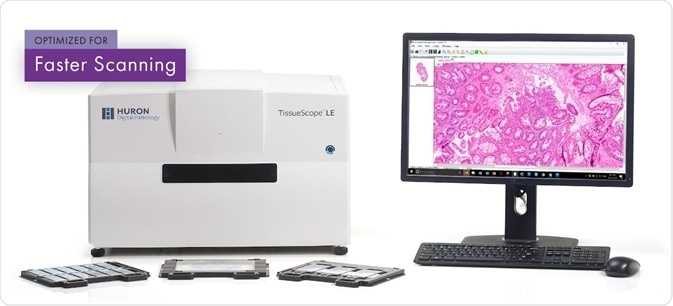Five years ago, my wife and I renovated our kitchen. We envisioned a unified look, but it wasn’t critical that all the appliances were from the same manufacturer – they just had to look and work well together. Through our selection process, numerous suppliers offered specials if we bought multiple appliances from the same manufacturer.
I’ll admit, it was tempting. The problem was, we really liked a particular side-by-side fridge/freezer combo from one manufacturer, but the accompanying range wasn’t as nice as the one from a different vendor and they didn’t have the size of wall oven we were looking for.
In the end, we took a “best-in-class” approach. The result was a kitchen that we were proud of, with components that worked seamlessly together, despite being from different manufacturers.
Anyone who is tasked with implementing a digital pathology workflow faces a similar dilemma. Do you buy from a single vendor or take a best-in-class approach? Let’s look at both approaches.
The Single Vendor Approach
From an administration standpoint, the single vendor approach is quite attractive. Your accounting manager will like it as they only need to set up a single vendor and process a single invoice. You will also likely appreciate the single point of contact. There’s one account manager to call and that person should be able to solve your problem. And, of course, working with a large company means that you have access to a wide range of resources – IT infrastructure, project management, regulatory, you name it.
Sounds great, right? Well, sort of. In practise, a complete solution from a single vendor can often be a combination of multiple components from different divisions within a company. Some components may have been developed in-house while other technology may have been licensed from other companies or otherwise acquired through acquisitions or mergers.
This means that some components may not be fully compatible with other parts, or the ease of use you enjoy in one part doesn’t extend to another. The pieces may be from the same company, but they may not feel that way. Also consider that the single point of contact you enjoy so much may, in fact, become multiple points of contact if the vendor has not seamlessly integrated their support network and you (or they) must navigate through multiple divisions and channels to get you an answer.
Then there’s vendor lock-in. Implementing a single vendor solution means that you kind of have to buy their components or at least those that are compatible with their solution. The single vendor will likely encourage you to purchase their component, which may not have the same features set as a third party option and will likely be more expensive. If it’s a must-have add-on it will be difficult, and potentially expensive and time consuming, to integrate into a closed system.
The Best-in Class approach
A successful digital pathology implementation begins with addressing the pathologist’s imagined workflow. Taking a best-in-class approach is particularly well suited to this because this approach is, by definition, flexible. It can easily conform to the needs of the pathologist, rather than require the pathologist to conform to it.
The best-in-class approach often means working with more than one vendor. The user will initially have a particular component in mind that they like. For example, it may be a slide scanner, image management software, or image analytics software. Then they will seek out complementary components to round out their end-to-end solution. In some cases, the scanner hardware vendor will take the lead and be the main interface with the user. In other cases, it will be the software vendor.

Image credit: Huron Digital Pathology.
By bringing multiple vendors together, each providing the best components, the pathologist’s imagined workflow can be realized as a truly custom, end-to-end digital pathology solution.
Four Practical Tips to Achieve Success with a Best-in-Class Approach
- First, determine that a best-in-class approach is right for you. What is your imagined workflow and what level of customization does it require? Are there any must-have components that you can’t live without?
- Seek out vendors that are the most passionate about their products and meeting your needs. Tap into the vendor’s in-depth product knowledge to give you and your colleagues added confidence that you are getting the very best (in-class). As a bonus, make sure they are willing to customize their products to meet your specific needs, something single vendors are often unable and unwilling to do.
- Verify technical interoperability and determine how well the vendors work together. Find out how well the whole slide scanner plays with the image management system. Does the software and hardware integrate with other parts of your workflow? How easy will it be to get issues resolved and who will resolve them? How will invoicing work?
- Finally, choose to work with great people. Sure, it’s technology, but look for people who you will want to work with long term.
About Huron Digital Pathology
 Based in Waterloo, Ontario, Canada, Huron Digital Pathology has a 20 year history designing sophisticated imaging instrumentation. Our end-to-end digital whole slide imaging solutions for digital pathology incorporate our award-winning TissueScope™ digital slide scanners; TissueView™ image viewing, sharing and management platform; and our workflow-enhancing accessories, which include our innovative TissueSnap™ preview scanning station.
Based in Waterloo, Ontario, Canada, Huron Digital Pathology has a 20 year history designing sophisticated imaging instrumentation. Our end-to-end digital whole slide imaging solutions for digital pathology incorporate our award-winning TissueScope™ digital slide scanners; TissueView™ image viewing, sharing and management platform; and our workflow-enhancing accessories, which include our innovative TissueSnap™ preview scanning station.
Sponsored Content Policy: News-Medical.net publishes articles and related content that may be derived from sources where we have existing commercial relationships, provided such content adds value to the core editorial ethos of News-Medical.Net which is to educate and inform site visitors interested in medical research, science, medical devices and treatments.